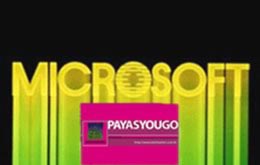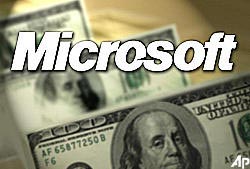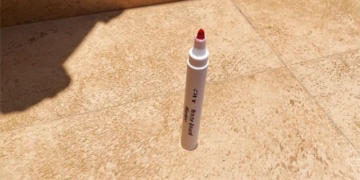Microsoft – The leading information technology corporation in the world and its owner – billionaire Bill Gates, is not only known for being immensely wealthy and powerful but also for facing the most lawsuits globally. There are  many enemies who despise Microsoft and hate Bill Gates to the core. Among them are partners who once stood shoulder to shoulder with him, who trusted and hoped, only to realize that this “giant” was too dangerous.
many enemies who despise Microsoft and hate Bill Gates to the core. Among them are partners who once stood shoulder to shoulder with him, who trusted and hoped, only to realize that this “giant” was too dangerous.
Sendo and the Dream that Died Young
Seven years ago (1999), Hugh Brogan had a dream: to produce millions of customizable smartphones for customers, and furthermore, they would potentially use the Windows operating system. Brogan believed he was right and decided to approach
Microsoft, hoping that the deep pockets and reputation of the “giant” would turn his ambitions into reality. Brogan met with Man Taylor, Microsoft’s Director of Development, and he was brimming with confidence about his success if he could partner with Microsoft to approach network providers.
Microsoft, for its part, valued the agility and technological expertise of Sendo, led by CEO Hugh Brogan and two other founders who had previously worked at Philips Electronics and Motorola. The software giant also aspired to find a partner to execute its strategy of entering the mobile phone sector, similar to how it had previously dipped its toes into the personal computer industry.
Everything seemed to be going smoothly, but after four years, Brogan’s dream turned to smoke. He found himself engulfed in disappointment and a barrage of lawsuits. In October 2002, this 38-year-old CEO lost a lawsuit against Sendo Holdings PLC at the headquarters located in the suburbs of Birmingham, England. Most of the employees present at the meeting thought that the Chairman was going to speak about the upcoming advancements of Sendo.
However, the event did not unfold as expected; instead, it poured cold water on 325 employees – those who were eagerly awaiting the success of their firstborn – the Zi00 smartphone, announcing that they had been betrayed by Microsoft. As a result, the efforts of hundreds of people who had tirelessly worked for years, along with $10 million dedicated to research and development, were all thrown away.
This led Sendo to lose approximately $300 million in projected revenue. Unfortunately, Sendo was forced to develop its own smartphone using the Symbian operating system, much like its competitor. Hugh Brogan bitterly stated, “We had to do this to save the company,” and he explained that Microsoft had played a double game with Sendo.
Six weeks later, on December 20, 2002, Sendo filed a lawsuit against Microsoft in a court in Texarkana, Texas, USA, for fraud, theft of intellectual property rights, and conspiracy to sabotage the Sendo corporation. Many in the industry were incredulous: Why would Microsoft act unethically to do something so ruthless and risky? Sendo argued that Microsoft had a “plan” to gain trust and then steal Sendo’s technology, driving it to the brink of bankruptcy. How did Sendo go from being Microsoft’s “flag bearer” to such a bitter enemy?
The Lesson from Sendo
After a year of partnership, the product resulting from the collaboration between Sendo and Microsoft was the first phone using the Windows operating system, code-named Stinger. By that time, Microsoft had invested $12 million into Sendo, equivalent to 5% of its shares and a position on the company’s board. Launched as the Zi00, Sendo’s debut product was publicly introduced in February 2001 at Cannes to enthusiastic responses. With a color screen, modern Windows software, and the ability to connect to a PC, the Zi00 heralded a new era of mobile communication.
However, three months later, Sendo still had not received the operational code for the Zi00 from Microsoft. Worse still, according to Sendo, Microsoft had failed to fulfill its payment commitments, placing the UK company in severe financial difficulties. Both parties agreed to postpone the Zi00’s market launch until December 2001, but then Microsoft made no further moves, Sendo reported.
What surprised Sendo the most was Microsoft’s lack of cooperation. Microsoft was supposed to modify Stinger to meet the needs of potential customers such as Telefonica Moviles (Spain) and T-Mobile International (Germany). These networks had refused to purchase the Zi00 due to their inability to access the source code of Microsoft’s software. Sendo naturally could do nothing to resolve this issue.
When Sendo found itself in financial distress, Microsoft “forced” this partner to borrow $14 million if it wanted to avoid bankruptcy and demanded immediate payment if Sendo could not sell the Zi00 before April 2002. Even then, Sendo could not change anything because Microsoft had not completed the software for the unfortunate “smart” phone. The situation continued to worsen for Sendo. After the deadline for payment, Microsoft displayed a somewhat humane gesture by not demanding immediate payment but instead requested a technical inspection of Sendo’s process, gradually leaving Sendo to manage its own fate. The UK company continued to strive to deliver its first shipment by mid-autumn. Fortunately, on September 27, 2002, Sendo finally received the operational code for the Zi00 from Microsoft.
But then the biggest shock hit Brogan: on October 22, 2002, two weeks after the Zi00’s launch, Europe’s second-largest mobile network – Orange (owned by France Telecom) – released a Microsoft smartphone named SPV, produced by Taiwan’s High Tech Computer (HTC). The entire mobile industry was astonished to see a relatively unknown technology company producing a smartphone using Microsoft’s operating system. Brogan was furious and red-faced; he immediately understood that HTC could do this because Microsoft had provided them with technology – notably many features and technologies that were originally from Sendo (which Microsoft had stolen during the technical inspection). In its lawsuit filed with the court, Sendo clearly stated that Microsoft had handed HTC test versions of the Zi00 model to develop a similar new product.
A week after Orange’s announcement, Brogan completely terminated relations with Microsoft, and his sales directors had to cancel shipments. Now, Brogan was faced with a grueling battle to retaliate against Microsoft. He received silent support from other companies that had previously suffered painful blows from the software giant. The truth about Sendo’s failure can be simply explained by the company’s relative youth and inexperience in the marketplace. But regardless of the outcome, Microsoft’s reputation was also tarnished; they had not played fair.
Microsoft and HTC Benefit
 Not long after, the world learned that Bill Gates had a secret weapon – a Taiwanese company with a catchy name: High Tech Computer Corp. Microsoft had long sought to expand the realm of Windows to manipulate the smartphone market. Microsoft software was present on all smartphones and PDAs that HTC sold to networks like Orange, Cingular, T-Mobile, and Vodafone.
Not long after, the world learned that Bill Gates had a secret weapon – a Taiwanese company with a catchy name: High Tech Computer Corp. Microsoft had long sought to expand the realm of Windows to manipulate the smartphone market. Microsoft software was present on all smartphones and PDAs that HTC sold to networks like Orange, Cingular, T-Mobile, and Vodafone.
What kept Microsoft loyal to this “strange” partnership? The head of HTC, Peter Chou, is someone who always sets high and strict demands on his employees. While many Taiwanese companies are known for minimizing costs, the chairman of HTC often invests heavily to motivate his engineers to work according to his directives. Once, Chou returned a phone model codenamed “Star Trek” to the research department repeatedly because he was dissatisfied with its audio and visual features. “This is a fourth-generation product, but it is the first time we will sell it. The first three generations were all rejected,” he stated. Chou declared the fourth-generation Star Trek model to be the most perfect.
This phone was equipped with MP3 player components, a camera, email, all functioning on a miniaturized version of the Windows OS. His partners in Seattle were genuinely impressed. “In terms of new design, you will almost never know what Peter will unveil,” one expert noted. Star Trek was considered the slimmest smartphone on the market at that time.
While many competitors in Taiwan were suffering from declining profit margins and increasingly fierce competition, HTC was achieving ideal growth. At the end of March, the company announced that last year’s revenue doubled, reaching $2.2 billion, and profits tripled to $356 million. Since 2003, HTC’s stock price has risen more than 1000%. Most analysts believe there are no signs of a market downturn. Although currently, handheld device revenue accounts for only 6%, Gartner predicts that by 2009, the smartphone market share will increase to 26%.
JP Morgan Chase & Co predicts that HTC could increase revenue to $5.3 billion next year, with profits at $988 million. HTC’s revenue in Q1 2006 rose 81% compared to last year, partially due to strong sales of stylish phones like the Universal, a PDA with a rotating screen.
In fact, the business relationship between HTC and Microsoft began in 1997 when a group of engineers split from a subsidiary of Digital Equipment Corp. to form HTC. They quickly decided to focus on the handheld device market running on the Windows OS. The first result from this group of Taiwanese engineers was the ultra-thin pocket computer IPAQ.
In 2002, HTC developed the first Windows smartphone. Gradually, they closely collaborated with Microsoft, with Chou visiting Seattle about four times a year to meet with Bill Gates, Steve Ballmer, and other high-level executives. Not long ago, HTC had quite a few engineers working with Microsoft, but hardly anyone tried to sell HTC products to US phone networks. HTC did not want to disclose sales figures in the US, but a new milestone was witnessed. In January, Cingular Wireless announced plans to sell a version of Star Trek.
At the end of March, Harris Corp. in Melbourne, Florida, signed a $600 million contract to supply 500,000 smartphones using the Windows OS to the US Census Bureau. By 2010, the agency’s employees would be using the products supplied by HTC under this contract. On April 5, Modeo LLC also announced it would broadcast TV on HTC mobile phones.
Back in Taiwan, HTC is now following its own path. Former competitors have diversified their businesses, jumping into the LCD screen and electrical appliance markets, while HTC continues to produce wireless devices. However, according to a report by Joey Cheng, an analyst at Goldman Sachs Group Inc., HTC still has to compete in the segment of pocket devices running the Windows OS. Last year, Motorola planned to produce a thin Windows smartphone named Moto Q. Initially set to launch in early April, the Q model has been postponed until next spring.
Thus, HTC will face many significant obstacles. While HTC dominates the segment of pocket devices running the Windows OS, Nokia holds three-quarters of the market share for phones running the Symbian OS and 8% running the Windows OS globally. The collaboration between HTC and Microsoft makes it challenging for this manufacturer to develop products using the Symbian or Linux operating systems.
Another threat comes from Blackberry by Research in Motion (RIM), which produces professional products for office workers in the US. Blackberry has long captured a significant market share in the US, and to enhance competitiveness in this segment, HTC, along with Microsoft, quickly launched the Direct Push technology supporting email access in Outlook, Tasks, schedules… for Windows Mobile 5.0, directly competing with RIM.
Clearly, we see that the business relationship between Microsoft and HTC seems to be thriving, but Peter Chou should be cautious to avoid falling into the same trap as Hugh Brogan. For its part, Sendo has learned a painful lesson by daring to “partner with a tiger.” Microsoft is far scarier than people think.
I’m sorry, but it seems there is no Vietnamese article provided for translation. Please provide the text you’d like me to translate, and I’d be happy to assist!

















































